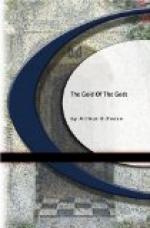THE PERUVIAN DAGGER
“There’s something weird and mysterious about the robbery, Kennedy. They took the very thing I treasure most of all, an ancient Peruvian dagger.”
Professor Allan Norton was very much excited as he dropped into Craig’s laboratory early that forenoon.
Norton, I may say, was one of the younger members of the faculty, like Kennedy. Already, however, he had made for himself a place as one of the foremost of South American explorers and archaeologists.
“How they got into the South American section of the Museum, though, I don’t understand,” he hurried on. “But, once in, that they should take the most valuable relic I brought back with me on this last expedition, I think certainly shows that it was a robbery with a deep-laid, premeditated purpose.”
“Nothing else is gone?” queried Kennedy.
“Nothing,” returned the professor. “That’s the strangest part of it—to me. It was a peculiar dagger, too,” he continued reminiscently. “I say that it was valuable, for on the blade were engraved some curious Inca characters. I wasn’t able to take the time to decipher them, down there, for the age of the metal made them almost illegible. But now that I have all my stuff unpacked and arranged after my trip, I was just about to try—when along comes a thief and robs me. We can’t have the University Museum broken into that way, you know, Kennedy.”
“I should say not,” readily assented Craig. “I’d like to look the place over.”
“Just what I wanted,” exclaimed Norton, heartily delighted, and leading the way.
We walked across the campus with him to the Museum, still chatting. Norton was a tall, spare man, wiry, precisely the type one would pick to make an explorer in a tropical climate. His features were sharp, suggesting a clear and penetrating mind and a disposition to make the most of everything, no matter how slight. Indeed that had been his history, I knew. He had come to college a couple of years before Kennedy and myself, almost penniless, and had worked his way through by doing everything from waiting on table to tutoring. To-day he stood forth as a shining example of self-made intellectual man, as cultured as if he had sprung from a race of scholars, as practical as if he had taken to mills rather than museums.
We entered a handsome white-marble building in the shape of a rectangle, facing the University Library, a building, by the way, which Norton had persuaded several wealthy trustees and other donors to erect. Kennedy at once began examining the section devoted to Latin America, going over everything very carefully.
I looked about, too. There were treasures from Mexico and Peru, from every romantic bit of the wonderful countries south of us— blocks of porphyry with quaint grecques and hieroglyphic painting from Mitla, copper axes and pottery from Cuzco, sculptured stones and mosaics, jugs, cups, vases, little gods and great, sacrificial stones, a treasure house of Aztec and Inca lore—enough to keep one occupied for hours merely to look at.




